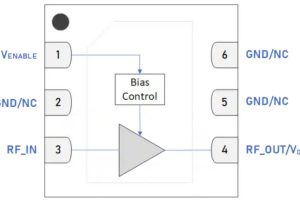
Called CYW20822-P4TAI040, it sleeps at 2μA when retaining 32kbyte of ram, or hibernates at 800nA – the latter rising to 950nA hibernating with the wake-up receiver enabled.
At maximum transmit power (+4dBm) up to 250m of range can be expected, and the receiver sensitivity is as high as -101dBm at 125kbit/s – 500kbit/s is also supported, as are 1 and 2Mbit/s.
It is pre-certified to FCC, ISED, MIC and CE regulations, according to Infineon.
 A built-in power management system means that the device will start-up from a battery voltage between 1.1 and 3.3V, and the module will run down to 1.0V. Operation is also across -45 to +85°C.
A built-in power management system means that the device will start-up from a battery voltage between 1.1 and 3.3V, and the module will run down to 1.0V. Operation is also across -45 to +85°C.
On-board peripherals include: 8x 16bit PWMs, up to 12x GPIO, quadrature decoder, analogue comparator, 2x UART, 2x SPI, 2x I2C and a 10bit ADC with one differential input or three single-ended inputs.
The actual module size is 20.2 x 10.5 x 2.3 mm and the base has castelated solder pads for surface-mount soldering.
Processing internally on a 16MHz Arm Cortex-M0 MCU, which shares space with 1Mbyte of embedded serial flash pre-programmed with software that “provides a command interface to configure and use the module” without programming, said Infineon. Over-the-air updates are possible.
The on-board track antenna typically has 4.21dBi peak gain and 10dB minimum return loss. It looks, and Electronics Weekly is checking this, like another version of the module CYW20822-P4EPI040 can accept an external pad antenna.
Use if foreseen industrial IoT, smart homes, asset tracking, beacons, sensors and medical devices.
 Electronics Weekly Electronics Design & Components Tech News
Electronics Weekly Electronics Design & Components Tech News



